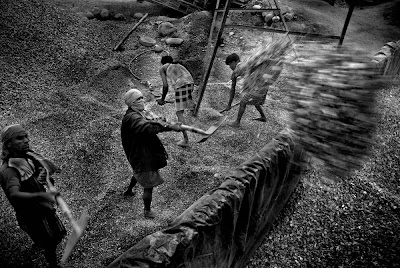More than 10,000 men, women and children work as stone laborers here. Uncontrolled and unstoppable stone extracting and crushing at Jaflong poses a serious threat to public health, and to the environment and agriculture in the area. There is no legal protection or concern about human rights violations in this stone industry.

Alfaj Hossain is a stone collector living in Banglabazar, two and a half kilometers from Jaflong.
He either walks or takes a boat ride from his home to work. Everyday he collects three boats full of stones and sales 150 taka ($ 2.17) per boat.

He either walks or takes a boat ride from his home to work. Everyday he collects three boats full of stones and sales 150 taka ($ 2.17) per boat.

Probad Das (age 67) and Priti Rani Das (age 39) are couple working together as stone laborers. They are working here for four years. They have two daughters. They used to earn 400 taka ($ 5.79) per day before. But now each of them earns 150 taka ($ 2.17) per day. Some day they only get 80 taka ($ 1.15) for their work.
Uses of modern machineries like cranes have caused stones to become extinct in some places in Piyain. For this reason the stone collectors have to work hard, every night with their boats they travel upstream to collect stones and dock it on the banks ready for
supply.
supply.
Stone collectors washing stones along Piyain River in Jaflong, Sylhet, Bangladesh. More than 2000 men, women and children are engaged in the stone crushing industry along the river bank.
Kalam Ali (age 26) has been working at a stone crushing machine for last 4 years. He knows there are many risk in stone crashing. He covers his face using his gamchha (local weaved cloth), as an attempted safety measure from breathing in dust particles.
Babul (age 32), Faruk (age 35), Manik (age 29) and Joinal (age 31) are loading a truck with broken downstone chips. These are transported to the city, to be used at multistoried
construction sites. They are also used for building roads and highways in different areas of Bangladesh.


Kobir Das (age 68) is a manual worker of stone. His village is in Dhirai. He is been working here for 10 years. He is a father of four sons and four daughters, but they do not take care of him. Therefore he still has to earn his own living. Earlier he used to earn 600 taka ($ 8.69) everyday. But now he earns 80 taka ($ 1.16) to 120 taka ($ 1.74) because there are many cranes being
used. He fears of losing his job in the coming years.
used. He fears of losing his job in the coming years.
Stone collector Abu Bakkar bathing at the bank of Piyain River after finishing his work.

Alya Begum, a stone crasher and mother of two children could not go to work because of illness. But without her wages she does not have money to buy food and medicine. Because there is no sick leave in this Stone Industry.

Shapna (age 13) works as a stone collector. Sometime she does not work because of her childish pranks. She is not old enough for the work. Between working times, she travels by her brother’s boat for fun.

Man and machine unites working day and night, to spin the life circle of the industry. Though there is light on the machines, but there is no emotion. On the other hand there is emotion in the labourers but a constant darkness is taking over their life.

















ไม่มีความคิดเห็น:
แสดงความคิดเห็น